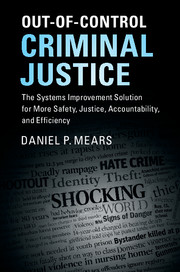 Out-of-Control Criminal Justice
Out-of-Control Criminal Justice Book contents
- Out-of-Control Criminal Justice
- Out-of-Control Criminal Justice
- Copyright page
- Dedication
- Contents
- Figures and Tables
- Preface
- 1 Introduction: Out-of-Control Criminal Justice
- 2 Systems Problems Are Not Specific to Crime and Justice
- 3 What Is a System?
- 4 The Criminal Justice System
- 5 The Systems Improvement Solution for Safety, Justice, Accountability, and Efficiency
- 6 Benefits of the Systems Improvement Solution and Pitfalls to Avoid in Implementing It
- 7 Conclusion: Criminal Justice under Control
- Notes
- References
- Index
- References
References
Published online by Cambridge University Press: 15 September 2017
- Out-of-Control Criminal Justice
- Out-of-Control Criminal Justice
- Copyright page
- Dedication
- Contents
- Figures and Tables
- Preface
- 1 Introduction: Out-of-Control Criminal Justice
- 2 Systems Problems Are Not Specific to Crime and Justice
- 3 What Is a System?
- 4 The Criminal Justice System
- 5 The Systems Improvement Solution for Safety, Justice, Accountability, and Efficiency
- 6 Benefits of the Systems Improvement Solution and Pitfalls to Avoid in Implementing It
- 7 Conclusion: Criminal Justice under Control
- Notes
- References
- Index
- References
- Type
- Chapter
- Information
- Out-of-Control Criminal JusticeThe Systems Improvement Solution for More Safety, Justice, Accountability, and Efficiency, pp. 277 - 303Publisher: Cambridge University PressPrint publication year: 2017


